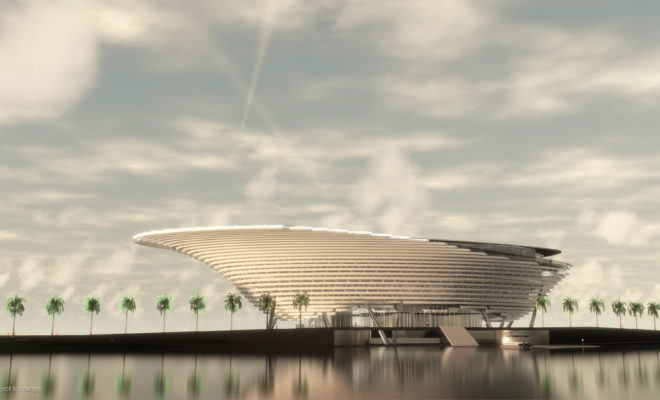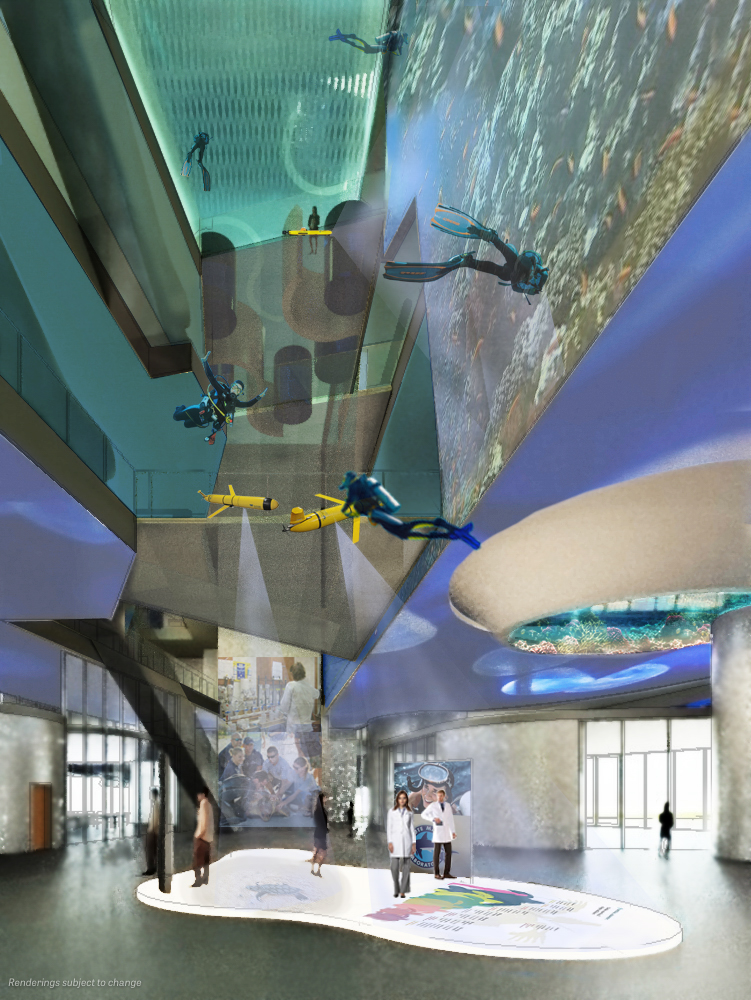
Community
Oceans For All
Mote’s Iconic New Aquarium to Pave Way for Future Marine Research
By Sue Cullen
Renderings of the proposed new Mote Science Education Aquarium show it perched at the edge of Nathan Benderson Park’s north lake’s west trail like a majestic four-story ship ready to launch. It is impressive, as is the ambitious plan to double exhibition space and attendance in a high-tech, hands-on learning environment, but it is just the first phase of Mote Marine Laboratory’s long-term vision.
The momentous rebirth of Mote Aquarium frees space at its current home on City Island and paves the way to expand its original raison d’être as a nonprofit marine research and exploration organization. “It is our longer-term vision beyond 2020 that is driving the need for us to grow,” said Dr. Michael P. Crosby, Mote’s President and CEO. “We have five campuses from Sarasota Bay to the Keys, and we are talking about growing again in a way that allows us to significantly evolve the City Island campus into an international marine science, technology and innovation center. The essential first step is that we need more space.” While the aquarium is Mote’s public face and a great attraction for visitors, it wasn’t established until 1980, while Mote has been involved in marine research since its founding by Dr. Eugenie Clark in 1955.
The aquarium’s mainland rebirth allows City Island to transform into an expanded hub to grow Mote’s research enterprise. That vision encompasses adequate space for additional Mote scientists, visiting scientists from around the world, and science and technology entrepreneurs with the capability to realize the market potential of groundbreaking research. That research includes discovery of infection- and cancer-fighting compounds from the sea, ocean sensing technology and sustainable fish farming methods, which have the potential to impact the quality of life for millions.
Mote’s vision for the new aquarium, which is being designed by the CambridgeSeven architectural firm, is equally expansive. It will have public space of 110,000 square feet, significantly larger than the current aquarium’s 66,000 square feet. More than 1 million gallons of seawater exhibits are planned, compared to about 400,000 gallons today, and they are expected to expand on Mote’s current display of more than 100 marine species. They will feature sharks, manatees, sea turtles, otters, seahorses, jellyfish and other marine life as well as ecosystems from around the world. Visitors’ experience will be heightened with augmented reality technology.
“When people see it, we want them to go, ‘Wow, that is incredible’,” Crosby said. “The building itself is designed to be an exhibit.” At night, the aquarium’s exterior will display still images and video of marine animals, the ecosystem and research endeavors. “Once people come in the door, they will be warmly embraced or smacked in the face with science. However you look at it, it won’t be your grandfather’s aquarium,” he said. “You will be immersed in science from virtual reality experiences to seeing students actively engaged with their teachers and our scientists in hands-on experience with STEM activities.” Visitors also will be able to participate in interactive teaching labs, onsite diving programs, and discover what it’s like to be a marine scientist by participating in Mote’s citizen-scientist projects.

This marine science and research focus expands upon efforts at the current aquarium, which recently completed an every-five-year accreditation by the Association of Zoos and Aquariums (AZA). A study of 228 AZA member institutions also named Mote the second most research-productive member with its inclusion in 641 research publications, closely behind the Smithsonian National Zoological Park, which had 650 publications.
Depending on timely completion of Mote’s $130 million fundraising effort, Oceans for All: Improving Access to Marine Science and Technology (941.388.4441/moteoceansforall.org), construction is planned to begin in late 2019 and be completed by late 2021. To date, funds already have been committed for 20 percent of the new aquarium’s cost. Discussions also are underway with Sarasota County officials for about five acres of county-owned land in Nathan Benderson Park as the aquarium’s new home.
“Our continued discussions have been very positive. I think everyone in the community sees the value when you look objectively at the growth of the community and the growth of Mote,” Crosby said. “It’s not just about science, it’s about the economy and our need for STEM education and STEM workforce development. Both are an important part of our new aquarium, and I think everyone wants to work together to make this happen.”
Although Mote’s informal science and ocean literacy education reaches more than 300,000 visitors annually, plans are to expand opportunities to provide area students with a higher level of science education. Hands-on activities in classrooms and interactive labs will be offered to all schools regionally at no cost. “Every child in this region will have the chance to have hands-on STEM opportunities they otherwise would not be able to have,” Crosby said. “They’ll have the opportunity to work with our scientists, and all high school students will have the chance to do hands-on research.” Plans include outreach to students from underserved populations and to those who are underrepresented in marine science and technology.
To create Mote Science Education Aquarium, the Oceans for All fundraising effort encompass three sources: individual donors, families and foundations, corporate and organizational sponsors, and local and state government funding. For individuals and families, Crosby said, “Whether you are into supporting conservation, recreational fishing, or paradigm-changing science, we have more than 20 research topics here focused on ensuring we do have oceans for all. We also want to reach out to those who see a once in a lifetime opportunity to be part of something incredibly important.” Over the past five years, Mote has had nearly 600 active research projects.
The Nathan Benderson Park location, with its proximity to I-75, puts 3 million residents within a one-hour drive of Mote Science Education Aquarium. Because its projected attendance numbers are so large, fundraising with large corporate sponsors is an opportunity. Feasibility studies put attendance in the first year at 700,000, double the current level, and the aquarium is built to accommodate 1 million visitors annually.
With projected economic impacts of the new aquarium and keeping in mind the longer-term desire to build a “blue economy” with a marine science and technology sector, local and state funding sources are being sought. The aquarium’s construction is projected to generate nearly $280 million in direct and indirect expenditures and employment of 3,123 in total person-years. Ongoing economic impact is estimated at $28 million annually, compared with today’s $12 million economic impact from the aquarium, and employment is expected at 260 direct and indirect jobs.
“We are going to do this together. It is going to be a community effort. The community helped build Mote into what it is today, and I can’t underscore enough that it is because we are in such a special community of people, we are very confident that we are going to achieve this goal,” Crosby said. “We are not just doing this to build and operate a new science education aquarium, the broader vision is that this aquarium allows us to have amazing impacts on the economy, the quality of life, and long-term conservation and sustainable use of our oceans.”
For the past 10 years, Sue Cullen has written about, and enjoyed, the Sarasota scene. When she’s not doing that, she works with clients in her PR/marketing business.



You must be logged in to post a comment Login